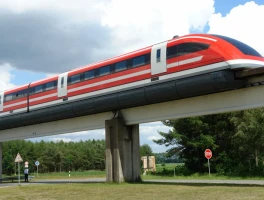Dr. Aris Thorne: The Maglev Dream Isn't Dead—It's Just Getting Started
Okay, folks, let's talk about the future. Specifically, let's talk about speed—the kind of speed that shrinks continents and redefines our understanding of distance. I'm talking about maglev trains. Now, I know what some of you are thinking: "Aris, didn't I just read that the Baltimore-DC maglev project just got canned?" Yes, you did. And yes, the headlines aren't pretty. "Feds pull plug," they say. Sounds like the end of the line, right? Wrong. Absolutely, unequivocally wrong.
See, here's the thing about innovation: it's messy. It's iterative. It's a relentless cycle of setbacks and breakthroughs. The cancellation of one project, even a high-profile one, doesn't negate the fundamental promise of maglev technology. In fact, it might just be the catalyst we need to push the technology forward, to refine it, and to deploy it in ways that are even more impactful.
This isn't just about building faster trains; it’s about reimagining transportation itself.
The Magnetic Revolution
Let's step back for a second and appreciate the sheer audacity of the idea: a train that floats on magnets, reaching speeds that rival airplanes. It sounds like something out of a sci-fi movie, doesn't it? But it's not science fiction. It's science fact. The core principle is simple, elegant, and revolutionary: use magnetic levitation to eliminate friction, the bane of all conventional rail systems. Two types of systems exist: electromagnetic suspension, which pulls the train up, and electrodynamic suspension, which pushes it away. Both achieve the same goal—a smooth, frictionless ride.
And the benefits are staggering. We're talking about trains that can reach speeds of over 600 kilometers per hour. Think about that for a moment. Imagine traveling from New York to DC in under an hour. Imagine the possibilities for business, for tourism, for simply connecting people and communities in ways we never thought possible.
But the benefits don't stop there. Maglev trains are also incredibly energy-efficient, consuming far less power per passenger than traditional high-speed rail, cars, or planes. They're quieter, reducing noise pollution in densely populated areas. And they require less maintenance, thanks to the lack of physical contact between the train and the track. They can even run on renewable energy, offering a path towards carbon-neutral transportation.
Now, I know what some of the naysayers are going to say. They'll point to the high upfront costs, the technical challenges, the regulatory hurdles. And yes, these are all valid concerns. But they're not insurmountable. We've overcome bigger challenges before. Remember when people thought that putting a man on the moon was impossible? Remember when the internet was just a niche technology for academics and researchers?
This is similar to the advent of the printing press. People were scared, but the access to information revolutionized society.

And let's not forget that maglev technology is already a reality in other parts of the world. The Shanghai Maglev has been zipping passengers between the city center and Pudong Airport at speeds of up to 430 kilometers per hour since 2004. Japan is constantly pushing the boundaries of maglev technology, with its L0 Series train reaching a top speed of 603 kilometers per hour in testing. In fact, just recently, reporters were left speechless witnessing the sheer speed of a $70 million Japanese Maglev train. I saw the footage, and honestly, I just sat back in my chair, speechless.
The US Transportation Secretary Sean P. Duffy said this Baltimore-DC project "lacked everything needed to be a success from planning to execution". This is an opportunity to learn from previous shortcomings and to come back stronger, smarter, and more determined than ever. Feds pull plug on Baltimore-DC maglev train project
What are we waiting for? I can see the future.
The Future is Magnetic
So, what does the future hold for maglev technology? Well, I believe we're only just scratching the surface of its potential. Engineers are already experimenting with running maglev trains through vacuum tubes, which could reduce air resistance to near zero and allow for speeds exceeding 1,000 kilometers per hour. Imagine that: traveling faster than commercial airplanes!
And it's not just about long-distance travel. City planners are exploring maglev technology for local transit, including elevated trams and bus systems. These applications could transform urban mobility, offering quiet, efficient transportation that doesn't contribute to street-level congestion or air pollution.
But here's the thing that really excites me: the potential for maglev technology to reshape our world in profound ways. Imagine a world where distance is no longer a barrier, where people can live and work wherever they choose, where goods and services can be transported quickly and efficiently across continents. This is the kind of world that maglev technology can help us create.
Of course, with great power comes great responsibility. As we develop and deploy these technologies, we need to be mindful of their potential impacts on society, on the environment, and on our own humanity. We need to ensure that these technologies are used for the benefit of all, not just for the privileged few.
What this means for us is that we need to invest in research and development, to foster innovation, and to create a regulatory environment that encourages responsible deployment. We need to educate the public about the benefits of maglev technology and to address their concerns. And we need to work together—government, industry, academia, and the public—to make this vision a reality.

